# Working with the Oracle connector
In this guide, we'll cover some tips and tricks for working with our Oracle connector.
# Table, view, and stored procedure
After successfully connecting to your Oracle database and selecting an action/trigger in your recipe, you will often be prompted to select either a table, view, or stored procedure. This tells Workato where to pull or send data to.
# Tables and Views
The Oracle connector works with all tables and views. These are available in pick lists in each trigger/action or you can provide the exact name. Views can be called using this as well and be used in the same way as a table.
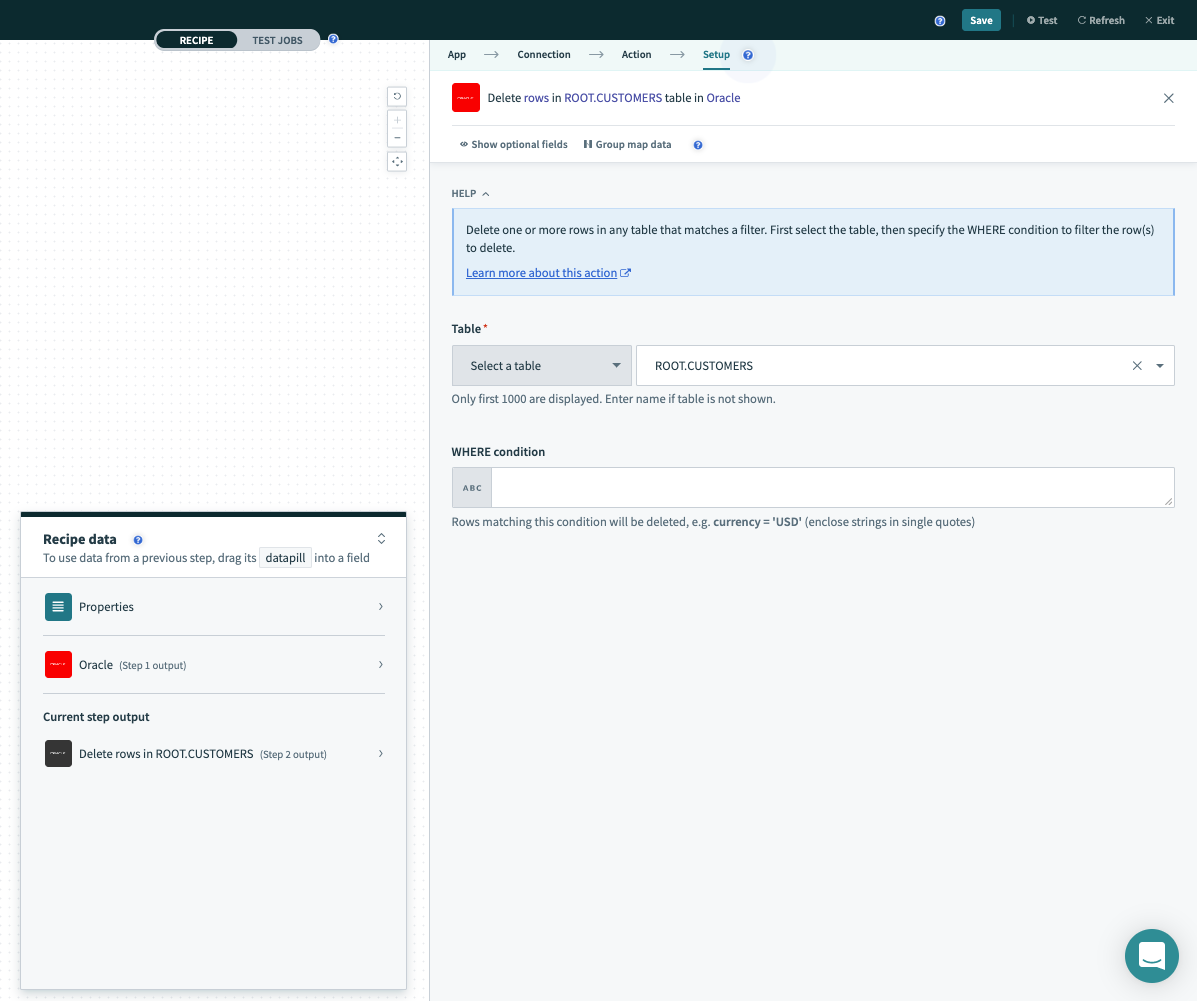
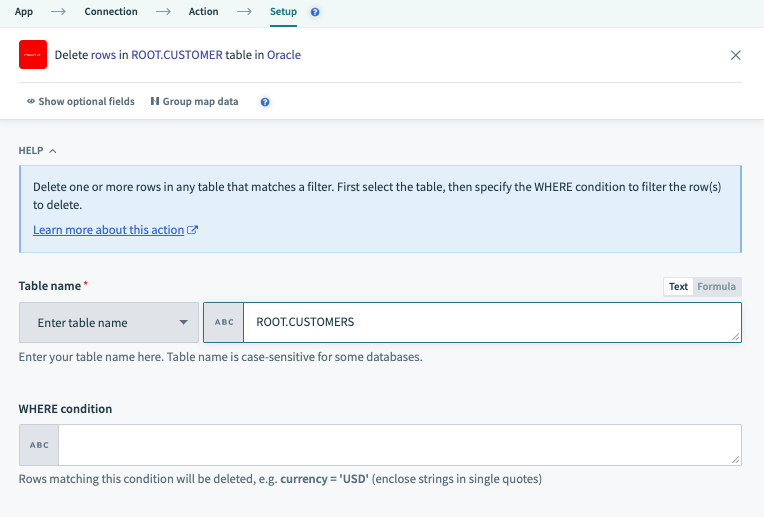
# Stored Procedures
Stored procedures are custom written workflows that have to be written and saved within your Oracle database. They are able to do a range of functionalities including creating, updating, and deleting rows. They can also accept parameters. Click here if you want to know more about how Workato works with stored procedures.
# Using WHERE conditions
This input field is used to filter and identify rows to perform an action on. It is used in multiple triggers and actions in the following ways:
- filter rows to be picked up in triggers
- filter rows in Select rows action
- filter rows to be deleted in Delete rows action
TIP
Examples below showcase how to use WHERE conditions directly with user input. For added security, use WHERE conditions with parameters to prevent SQL injection. Learn more
This clause will be used as a WHERE statement in each request. This should follow basic SQL syntax. Refer to this Oracle documentation (opens new window) for a full list of rules for writing Oracle statements.
# Operators
At the foundation of any WHERE statement, we have operators that help us filter and identify what rows we want returned in Workato. By chaining operators in the same way one would do it in SQL, you'll be able to use them to create robust and complex filters on your data directly from Workato.
Click here for a list of operators
Operator Description Example = Equal WHERE ID = 445!=
<>Not equal WHERE ID <> 445>
>=Greater than
Greater than or equal toWHERE PRICE > 10000<
<=Less than
Less than or equal toWHERE PRICE > 10000IN(...) List of values WHERE ID IN(445, 600, 783)LIKE Pattern matching with wildcard characters ( %and_)WHERE EMAIL LIKE '%@workato.com'BETWEEN Retrieve values with a range WHERE ID BETWEEN 445 AND 783IS NULL
IS NOT NULLNULL values check
Non-NULL values checkWHERE NAME IS NOT NULL
# Data types
The other component of a WHERE condition would be to use these operators in conjunction with the proper datatypes. When writing WHERE statements, make sure you compare a variable of data type = integer in your table with a variable of data type = integer instead of data type = string.
Workato also helps reveal the data types expected for each input field when you select
- Update rows actions
- Upsert rows actions
They appear directly below the output field, allowing you to know the expected data type to be sent while building the recipe. Use these hints to send the proper data types over to your Oracle database as failing to do so might lead to unexpected behavior or failed jobs.
Here are some common data types you can expect to see. A more comprehensive list can be found here (opens new window)
Click here for a list of common data types
Data type Description Example number The NUMBER data type stores zero, positive, and negative fixed numbers. -100,1,30,000FLOAT The FLOAT data type is a subtype of NUMBER. You can specify it with or without precision. Scale cannot be specified, but is interpreted from the data. Each FLOAT value requires from 1 to 22 bytes. 1.11,2.0761,1.61803398875YEAR valid values are -4712 to 9999 excluding year 0 1,245,100MONTH 01-12 1DAY 01-31 1,0,15VARCHAR2(n) Variable width character string of length nFoo_barnchar(n) Fixed width character string of length nFoowhere n = 3TIMESTAMP From January 1, 1753 to December 31, 9999 with an accuracy of 3.33 milliseconds 2011-09-16 13:23:18.767
# Writing WHERE conditions
Now that we've gone through operators and data types, we are ready to write our WHERE conditions. String values must be enclosed in single quotes ('') and columns used must exist in the table/view.
A simple WHERE condition to filter rows based on values in a single column looks like this.
currency = 'USD'
If used in a Select rows action, this WHERE condition will return all rows that have the value 'USD' in the currency column. Just remember to wrap datapills with single quotes in your inputs.
WHERE conditionColumn names that do not conform to standard rules (includes spaces, lower-case letters or special characters) must be enclosed in double quotes (""). For example, PUBLISHER NAME must be enclosed in backquotes to be used as a valid identifier.
"PUBLISHER NAME" = 'USD'

WHERE condition with enclosed identifierClick the tabs below for more details into the functionality you can explore with your WHERE conditions.
Using
ANDandORin yourWHEREconditionsWHEREconditions can also be used in conjunction with basic SQL logical operators likeANDandORto add more filters on the rows you return.("currency code" = 'USD' AND totalAmt >1000) OR totalAmt>2000When used together, this
WHEREcondition will return all rows that either have the value 'USD' in thecurrency codecolumnANDmore than 1000 in thetotalAmtcolumnORmore than 2000 in thetotalAmtcolumn
Using sub-queries in your
WHEREconditionsYour
WHEREcondition can also contain subqueries. The following query can be used on theuserstable.ID IN (SELECT "USER ID" FROM TICKETS WHERE PRIORITY >= 2)When used in a Delete rows action, this will delete all rows in the
userstable where at least one associated row in theticketstable has a value of 2 in theprioritycolumn.
Using datapills in WHEREcondition with subquery
# Using Parameters
Parameters are used in conjunction with WHERE conditions to add an additional layer of security against SQL injection. To use parameters in your WHERE conditions, you will first need to declare bind variables in your input. Bind parameters must be declared in the form :bind_variable where the variable name is preceded with a :. After this is done, declare the parameter in the section directly below using the exact name you have given.
TIP
Bind variables should only be used in place of column values and not column names.
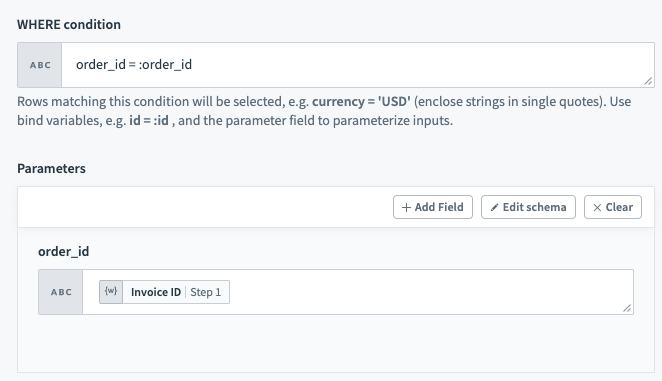
WHERE condition with bind variableYou can provide as many bind variables as you'd like and each one should have a unique name. We distinguish bind variables from column names and static values by ignoring any : inside single quotes ('), double quotes (") and square brackets ([]).
# Configuring triggers
Oracle connector has triggers for both new and updated rows. For the triggers to work, both Unique keys must be configured. Sort columns need to be configured for triggers that find recently updated rows.
A table must satisfy some constraints to be used in a trigger. The following sections contain more information about specific constraints. Read our best practices to find out how you can prepare your table for use with Workato
# Unique keys
In all triggers and some actions, this is a required input. Values from this selected column are used to uniquely identify rows in the selected table. As such, the values in the selected column must be unique. Typically, this column is the primary key of the table (for example, ID).
When used in a trigger, this column must be incremental. This constraint is required because the trigger uses values from this column to look for new rows. In each poll, the trigger queries for rows with a unique key value greater than the previous greatest value.
Click here for a detailed example
Let's use a simple example to illustrate this behavior. We have a New row trigger that processed rows from a table. The unique key configured for this trigger isID. The last row processed has100as it'sIDvalue. In the next poll, the trigger will use>= 101as the condition to look for new rows. Performance of a trigger can be improved if the column selected to be used as the unique key is indexed.
# Sort column
This is required for New/updated row triggers. Values in this selected column are used to identify updated rows.
When a row is updated, the Unique key value remains the same. However, it should have it's Sort column updated to reflect the last updated time. Following this logic, Workato keeps track of values in this column together with values in the selected Unique key column. When a change in the Sort column value is observed, an updated row event will be recorded and processed by the trigger.
For Oracle database, only date, timestamp, timestamp with time zone and timestamp with local time zone column types can be used.
Click here for a detailed example
Let's use a simple example to illustrate this behavior. We have a new/updated row trigger that processed rows from a table. The Unique key and Sort column configured for this trigger isIDandUPDATED_ATrespectively. The last row processed by the trigger hasIDvalue of100andUPDATED_ATvalue of2018-05-09 16:00:00.000000. In the next poll, the trigger will query for new rows that satisfy either of the 2 conditions:
1.UPDATED_AT'2018-05-09 16:00:00.000000'
2.ID> 100 ANDUPDATED_AT = '2018-05-09 16:00:00.000000'
# Using single row actions/triggers vs using batch of rows actions/triggers
Oracle connector can read or write to your database either as a single row or in batches. When using batch triggers/actions, you have to provide a batch size you wish to work with. The batch size can be any number between 1 and 100, with 100 being the maximum size limit. Batch triggers and actions are great for jobs when you expect to read, create, or update a large number of rows. Choosing to batch your job runs rather than having them split into separate jobs runs not only saves operations but reduces recipe runtimes and decreases load on your servers.
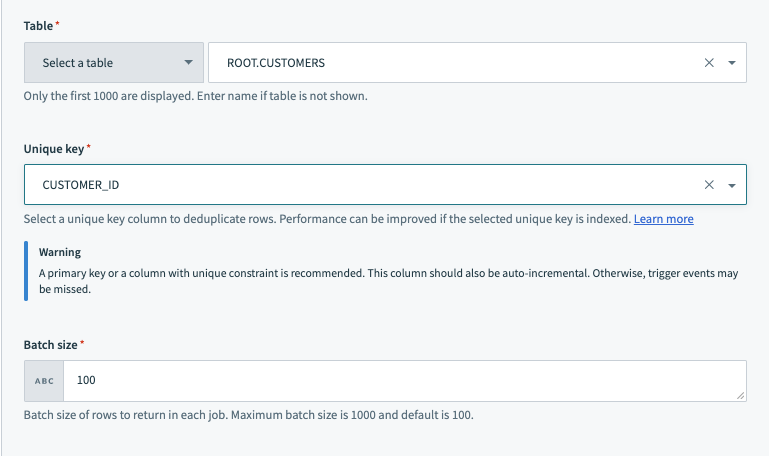
Besides the difference in input fields, there is also a difference between the outputs of these 2 types of operations. A trigger that processes rows one at a time will have an output datatree that allows you to map data from that single row.
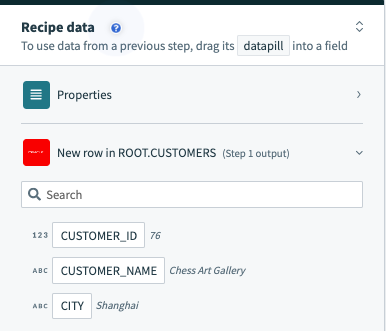
However, a trigger that processes rows in batches will output them as an array of rows. The Rows datapill indicates that the output is a list containing data for each row in that batch.

As a result, the output of batch triggers/actions needs to be handled differently. This recipe (opens new window) uses a batch trigger for new rows in the users table. The output of the trigger is used in a Salesforce bulk upsert action that requires mapping the Rows datapill into the source list.
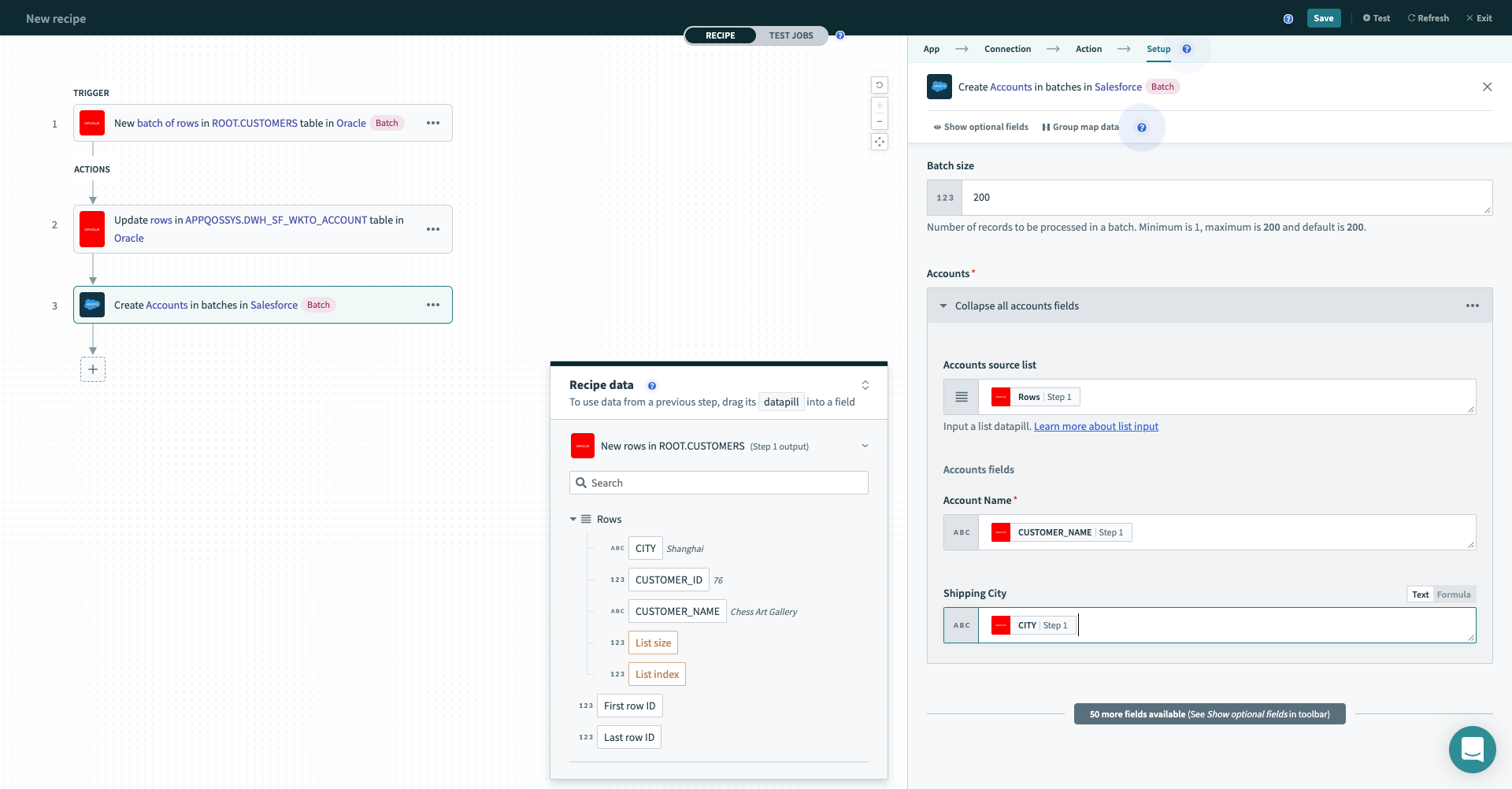
Outputs from batch triggers/actions can also be used outside of actions that work specifically with lists. By using Workato's repeat step, you'll be able to control batch outputs and use them with any action built for single rows..
Unsure when to use batch actions and single row actions? Check out our best practices section for recipe design tips!
# Smart boolean conversion
Oracle does not have a built-in boolean column type. A popular workaround is to use a NUMBER(1,0) column with a CHECK (COLUMN_NAME IN(1,0)) constraint. Because of this, standard values from other applications will not map well to this column and may cause unexpected values or errors.
This checkbox allows you to enable automatic smart conversion. If this is set to Yes, the conversion will be applied to all columns with NUMBER type and precision of 1. This reduces the amount of configuration needed to transform datapills in a recipe. The following table describes the logic for the boolean conversion.
| Input value | Converted value |
|---|---|
true | 1 |
false | 0 |
"true" | 1 |
"false" | 0 |
Last updated: 12/17/2025, 6:17:46 PM